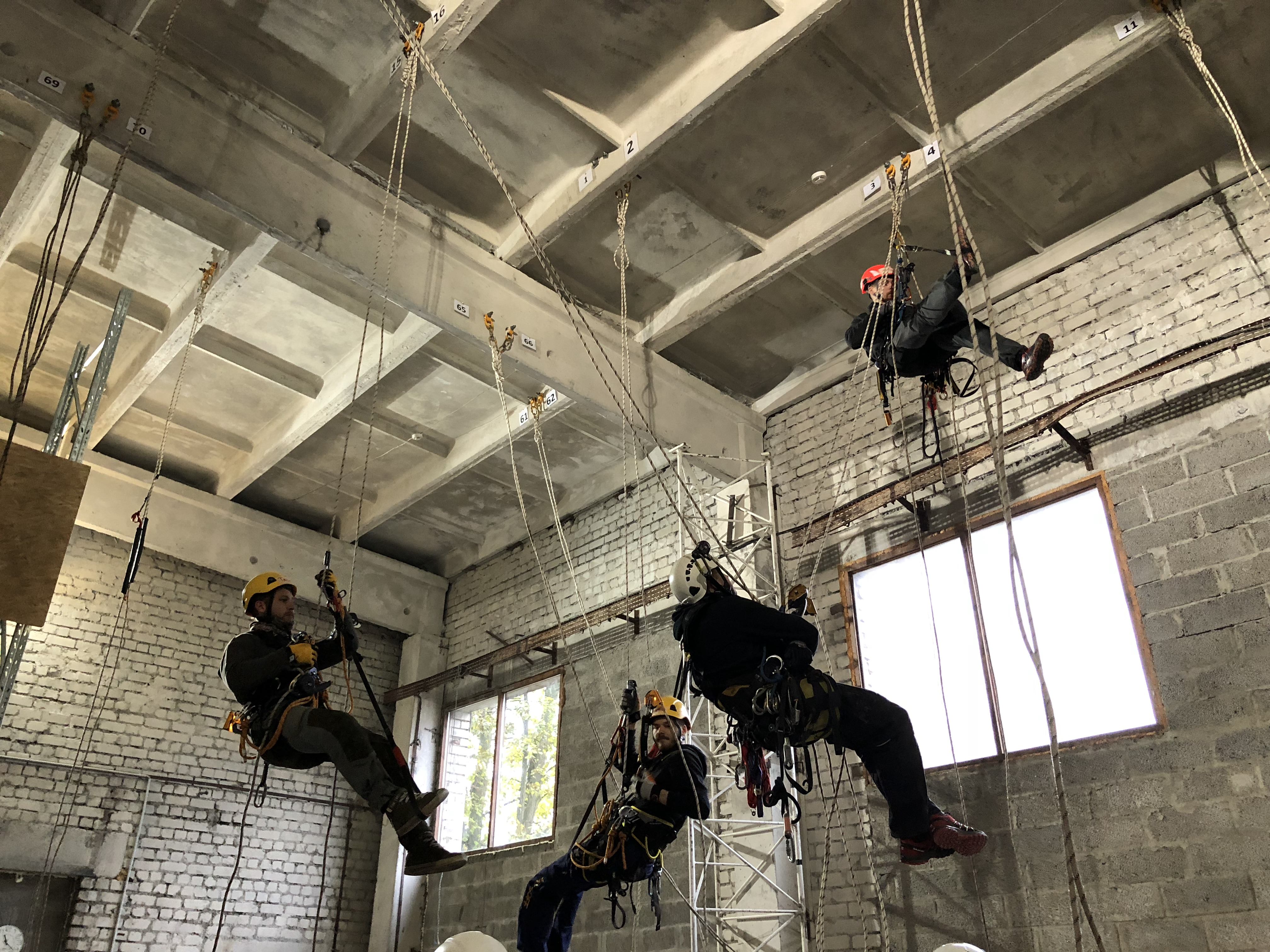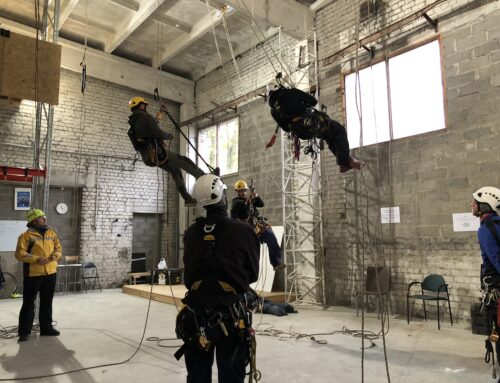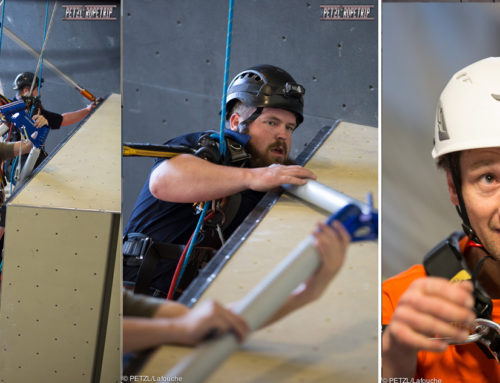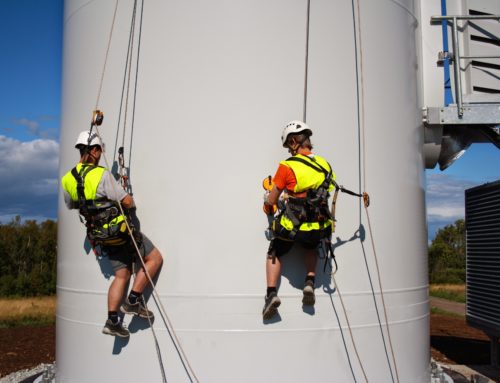In addition to working at height, Skyproff also gives out different trainings. The longest, most expensive and most extensive is the IRATA training (given out by our partner GAT International). This international rope access training often creates a lot of questions. Read more and find out, who this course is for, why it is so valued and what you can do with the knowledge.
Here are some reasons why we recommend participating in the IRATA course:
- International certificate
IRATA, short for International Rope Access Trade Association, is the most recognized organisation in the field of working at height and rope access, followed by the USA-s SPRAT (Society of Professional Rope Access Technicians). IRATA was formed in the 1980s, when the different industrial and constructional uses of rope access became more widely known.
IRATA:- Brings together all certified rope access technicians and trainers,
- Gives out safety guidelines and recommendations,
- Ensures a high training quality in its official partner companies,
- Works to make the field of rope access ever more safe and better-known.
- High safety standards
IRATA trainings can only be given:- In training venues that have passed a special audit,
- Using exclusive training equipment,
- Following a specific training structure,
- Under the supervision of experienced and licenced professionals.
Each IRATA training company follows the most strict safety standards to ensure the safety of all participants and a high-level training. If they fail to do so, they risk losing their training licence. Each year, an internal audit is carried out, and every three years an IRATA representative carries out the audit.
Oftentimes, IRATA guidelines and standards are much more strict than the laws, because national guidelines haven’t yet caught up with the fast development of rope access and working at height. This way IRATA helps to secure best practices in situations where the law doesn’t give enough guidance.
- A level for everyone
IRATA rope acces technicians can have three different levels.- Level 1 – beginner. Is capable of executing the most common rope access works under the supervision and guidance of a Level 3 technician.
- Level 2 – mid-level. Has more advanced knowledge about equipment, rescue and rope access methods.
- Level 3 – supervisor. Has knowledge about different working techniques and the law; organizing works at height and rescues; has a valid first aid certificate. May be the supervisor and safety responsible at work sites; may train new rope access technicians.
You can only move to the next level after working at least one year and at least 1000 hours. Also, you must pass the training and the exam. Every three years, the existing level must be renewed or upgraded.
- Multi-faceted, experienced trainers
IRATA trainings are generally given by 2-3 trainers from different countries. This ensures many languages, different experiences and teaching styles and helps to create the best training experience. The exams are evaluated by an independent Assessor, thus guaranteeing objectivity.Because every trainer must also regularly update their Level 3 qualifications, it means that:- They don’t just train, but also work on different projects,
- They have years of experience in their field,
- They have participated in many IRATA trainings themselves and know how it is from the participant’s perspective,
- They have vast knowledge about safety, security and first aid.
- New contacts in the field of rope access
Rope access is fast-growing field in the industry. Rope access technicians can perform a wide variety of jobs, for example in construction, installation, maintenance and cleaning. Oftentimes there is cooperation between companies. So you will benefit from a wide web of contacts to find both work and workers.In the IRATA course you will meet new and experienced technicians and get to know your trainers. The course lasts for almost a week – enough time to connect people and help you network. - Training environment that mimics real life
Every IRATA training venue must meet certain requirements to ensure a training quality that meets high standards. For example, the training room must be at least 7 meters high. The size and height of the training venue help create a “real” feeling of working at height. Different anchor points and ropes are placed optimally so that several people could exercise at the same time without interrupting each other.In Skyproff’s training venue we also have equipment for imitating power towers and a high platform for descending over the edge or through a hatch. In the wintertime, it is chilly, to keep the environment as close to real life as possible. Still, the trainees are protected from wind and rain.
Who is the training meant for?
Anyone who is at least 18 years old and physically capable of safely working at height is welcome to join the IRATA course! Only a severe fright of heights is an obstacle – a little bit of fear is normal and even encouraged.
How you can use the knowledge from this course depends on what you can already do. IRATA only focuses on the access method, but to become successful in rope access, climbing is not enough. Before you register, think what you could do with your new skills – painting, installing billboards, washing windows or conducting roof audits? There are of course many options, but keep in mind that you won’t get any construction- or maintenance-related skills from this course.
Both men and women are welcome – contrary to what a lot of people think. There is no upper age limit – it all depends on your own health and fitness.
We especially recommend this training to:
- Skilled workmen who wish to
- Widen their work opportunities
- Try something new
- Add more excitement to what they do
- (Builders, painters, electricians, cleaning experts etc)
- People interested in working in heights internationally
- Anyone who craves an active and physically demanding job in fresh air
- Anyone who craves daily adrenaline rushes and challenges



